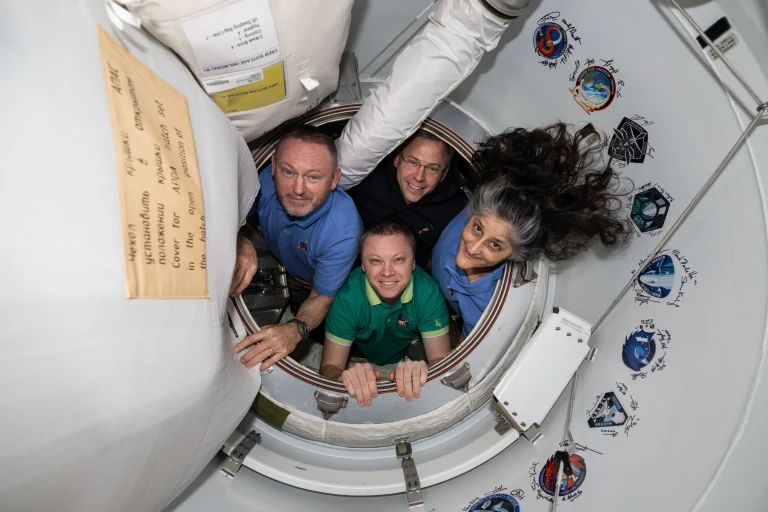NASA astronaut and Expedition 72 Commander Suni Williams checks out the Astrobee robotic free-flyer in the Kibo laboratory module outfitted with tentacle-like arms containing gecko-like adhesive pads to demonstrate satellite capture techniques. Development of this robotic technology may increase the life span of satellites and enable the removal of space debris.
NASA
In this picture from Nov. 15, 2024, Astronaut Suni Williams imitates the tentacle-like arms of the Astrobee robotic free-flyer in the foreground.
Astrobee robots help astronauts reduce time they spend on routine duties, leaving them to focus more on the things that only humans can do. Working autonomously or via remote control by astronauts, flight controllers or researchers on the ground, the robots are designed to complete tasks such as taking inventory, documenting experiments conducted by astronauts with their built-in cameras or working together to move cargo throughout the station. In addition, the system serves as a research platform that can be outfitted and programmed to carry out experiments in microgravity – helping us to learn more about how robotics can benefit astronauts in space.
Image credit: NASA
NASA宇航员兼第72号远征队指挥官苏尼·威廉姆斯(Suni Williams)在希望号实验舱内检查了Astrobee自由飞行机器人。这款机器人配备了类似触须的机械臂,臂上装有类似壁虎脚垫的粘附垫,用于演示卫星捕获技术。这项机器人技术的开发可能延长卫星的寿命,并使清除太空垃圾成为可能。
影像来源: NASA
在这张2024年11月15日拍摄的照片中,宇航员苏尼·威廉姆斯模仿了Astrobee自由飞行机器人前景中类似触须的机械臂。
Astrobee机器人帮助宇航员减少在例行任务上花费的时间,从而让他们能更专注于人类独有的任务。这些机器人可以自主工作,也可以由宇航员、飞行控制人员或地面研究人员远程控制,设计用于完成诸如库存管理、利用内置摄像头记录宇航员进行的实验,或者协同工作搬运货物等任务。此外,这一系统还作为一个研究平台,可以被配置和编程以在微重力环境中进行实验——帮助我们更多地了解机器人如何在太空中为宇航员提供支持。
影像来源: NASA







